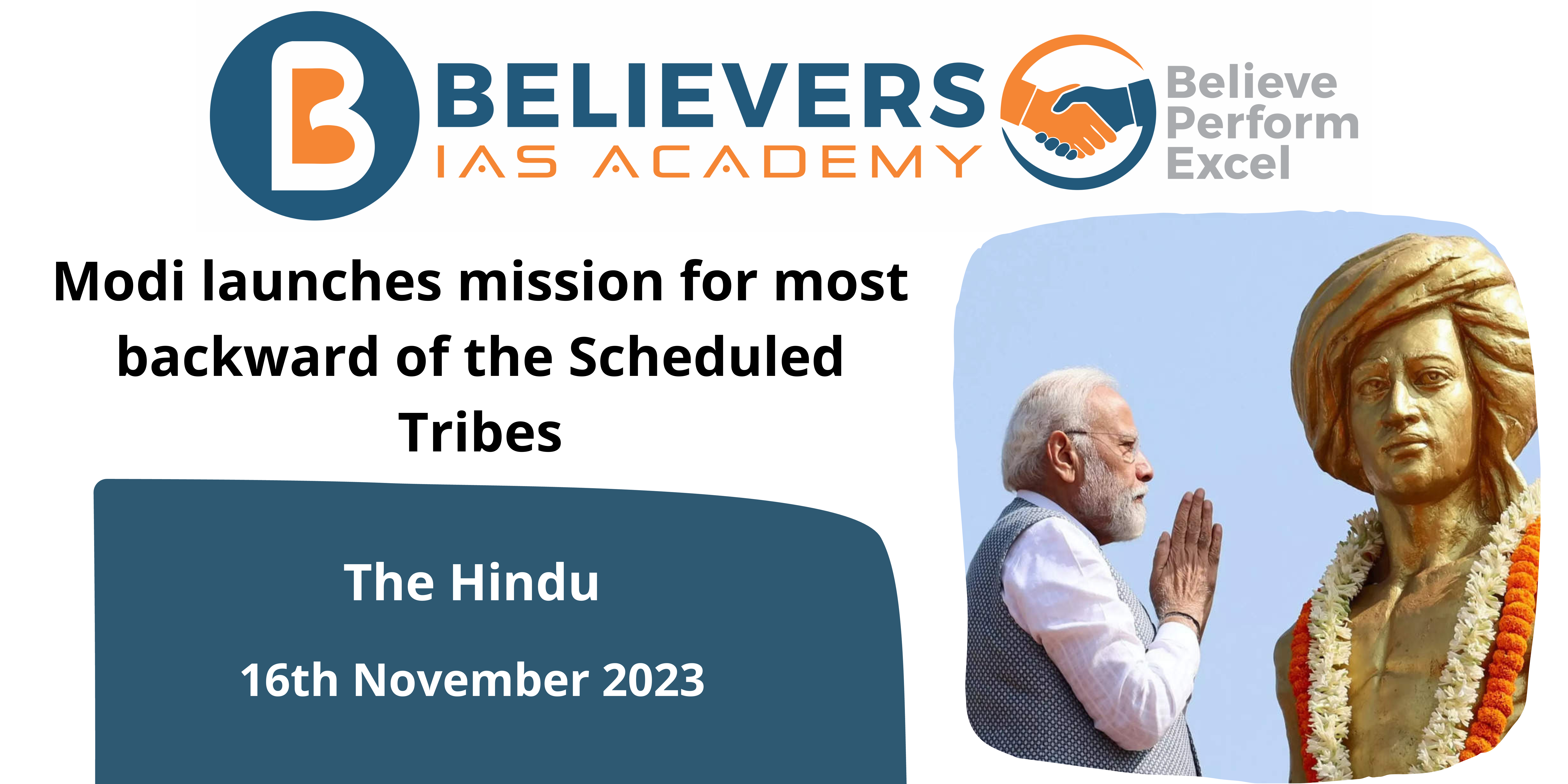Modi launches mission for most backward of the Scheduled Tribes
Context
Along with launching new missions to uplift the SC and ST, the Prime Minister also released the 15th instalment of the PM-Kisan payout to farmers and dedicated a slew of projects worth over 7,000 crores to the nation, including an IIM campus in Ranchi and projects in the coal, railways, roads, petroleum, and natural gas sectors in Jharkhand.
What are Particularly Vulnerable Tribal Groups?
Tribal communities are frequently defined by certain characteristics such as primitive qualities, particular culture, geographical isolation, shyness to contact with the larger population, and backwardness. Along with these, certain tribal tribes have distinct characteristics such as reliance on hunting and gathering for food, pre-agriculture technologies, zero or negative population growth, and extremely low literacy. These are known as Particularly Vulnerable Tribal Groups.
What are the new schemes launched on behalf of these vulnerable groups?
- The Pradhan Mantri PVTG Development Mission (PM-PVTG Development Mission) aims to enhance the socio-economic situations of tribal communities that are particularly vulnerable. The mission will provide essential services such as:
- Safe housing
- Clean drinking water and sanitation
- Improved access to education, health, and nutrition
- Road and telecommunications connectivity
- Sustainable livelihood opportunities
- The mission was announced in the 2023-24 Budget. On ‘Tribal Pride Day,’ the birth anniversary of Lord Birsa Munda, Prime Minister Narendra Modi inaugurated the mission in Khunti district on November 15, 2023.
- The mission is budgeted at 24,000 crore.
How are these groups identified?
- The government of India follows the following criteria for the identification of PVTGs.
- Pre-agricultural level of technology
- Low level of literacy
- Economic backwardness
- A declining or stagnant population.
What are the features of this scheme introduced by the PM Modi?
- Occasion & Launch:
-
- Prime Minister Narendra Modi started the Viksit Bharat Sankalp Yatra on Janjatiya Gaurav Divas, the birth anniversary of tribal leader Birsa Munda.
- The Yatra started in Khunti, Jharkhand, using specially equipped Information, Education, and Communication (IEC) Vans.
- National Launch:
-
- Important dignitaries, including Governors, Chief Ministers, Union Ministers, and Ministers of State, flagged off similar IEC vans in 68 districts across the country.
- The Yatra intends to visit locations with a sizable tribal population.
- Jammu and Kashmir Launch:
-
- The Sankalp Yatra was launched in Jammu and Kashmir from Budhal and Gurez villages, with the participation of residents, youth, Panchayat Raj institutions, and government officials.
- Lt. Governor Manoj Sinha joined the ceremony via video conference.
- Themes Covered:
-
- The Yatra aims to raise awareness and provide information about various government welfare programs, including sanitation, banking services, electrical connections, housing, food security, healthcare, and others.
- Specific tribal concerns, like as the Sickle Cell Anaemia Elimination Mission and scholarship programs, are also addressed.
- Branding and IEC Vans:
-
- IEC Vans have been branded and adapted to communicate information in Hindi and state languages using audio visuals, leaflets, pamphlets, booklets, and flagship standees.
- The vans highlight key projects, highlights, and accomplishments at the national, state, and district levels.
- Campaign Objectives:
-
- By January 25, 2024, the Viksit Bharat Campaign hopes to have covered over 2.55 million Gram Panchayats and over 3,600 urban local authorities.
- The initiative has a ‘whole-of-government’ approach, with state governments, district administrations, urban local bodies, and Gram Panchayats all actively participating.
What are the benefits of these schemes for the scheduled classes?
- Infrastructure and basic amenities: Schemes such as the PM-Gram Sadak Yojana and the PM-Gram Awaas Yojana aim to solve fundamental infrastructure needs by providing all-weather road connectivity and affordable housing.
- Availability of Safe Drinking Water: Jal Jeevan Mission focuses on providing clean and adequate drinking water, which is a basic essential for health and sanitation.
- Health Insurance: Ayushman Bharat and PMJAY provide health insurance coverage, providing financial security for healthcare bills as well as access to high-quality medical facilities.
- Food security: Prime Minister Garib Kalyan on Food Security Anna Yojana offers free food grains, hence promoting food security in vulnerable segments of society.
- Opportunities for Earning a Living: The Deendayal Antyodaya Yojana – National Rural Livelihoods Mission promotes self-employment and entrepreneurship, as well as economic empowerment.
- Clean Cooking Fuel: The PM Ujjwala Yojana addresses the issue of indoor air pollution by giving free LPG connections and encouraging people to utilize clean cooking fuel.




